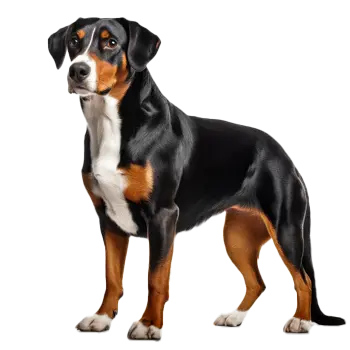The Appenzell Mountain Dog can be an exceptional family companion, but success requires the right match between dog and household. These are not dogs for everyone, and potential owners must honestly assess whether they can meet this breed's substantial needs for activity, training, and involvement in family life. The ideal home for an Appenzeller includes experienced dog owners who lead active lifestyles and have the time and commitment to properly train, exercise, and socialize their dog.
When it comes to children, Appenzellers can form wonderful bonds with kids who are old enough to interact appropriately with dogs. The breed's playful nature and high energy make them enthusiastic playmates for older children who understand proper dog interaction and can participate in activities like hiking, running, or playing fetch. However, these dogs are generally not recommended for families with toddlers or very young children. Appenzellers can be exuberant and may accidentally knock over small children during play. More significantly, their herding instinct can manifest as nipping at heels, chasing running children, or attempting to "control" children's movements—behaviors that are natural expressions of their working heritage but inappropriate and potentially frightening in a family setting.
Early socialization with children is essential, as is teaching both the dog and children how to interact safely and respectfully. Children must learn not to disturb the dog during meals or rest, to recognize signs of stress, and to engage in appropriate play. Supervision remains important regardless of how well-trained the dog may be. With proper management, training, and supervision, many Appenzellers become devoted guardians of their family's children, watching over them with the same protective instinct they once applied to livestock.
Living space requirements favor homes with securely fenced yards where the dog can run and play. While Appenzellers can technically adapt to apartment living, this arrangement presents significant challenges due to the breed's high exercise needs, tendency to bark, and need for space to move. Urban apartment dwellers who work full-time will struggle to provide adequate exercise and stimulation. These dogs need opportunities for off-leash running in safe areas, access to varied terrain and activities, and enough space that their energy doesn't feel constrained.
Rural or suburban homes with access to hiking trails, open spaces, and dog sports facilities represent ideal environments. The breed's heritage as a farm dog means they appreciate having territory to patrol and monitor. Fencing must be secure—at least five feet high—as Appenzellers are athletic and may attempt to jump fences if something interesting appears on the other side. They are not dogs who can be left to free-roam; their protective instincts, prey drive, and tendency to patrol their territory make unsupervised outdoor access problematic.
Climate tolerance is excellent, thanks to the breed's origins in the Swiss Alps. The thick double coat provides insulation against cold weather, and Appenzellers often seem most comfortable in cooler temperatures. They can tolerate heat reasonably well but require access to shade, fresh water, and rest during hot weather. Their activity level should be adjusted during temperature extremes—exercise during cooler parts of the day in summer and watch for signs of overheating during strenuous activity.
Multi-pet households require careful consideration. Appenzellers can coexist successfully with other dogs when properly socialized from puppyhood. However, they may display dominance, especially same-sex aggression, and need owners who can manage multiple dogs effectively. Introductions should be gradual and supervised, with care taken to prevent bullying or fights over resources. Households with multiple male dogs may face particular challenges.
Compatibility with cats and other small pets is variable and depends heavily on early socialization and individual dog temperament. The breed's herding instinct and moderate prey drive mean they may chase cats, especially if the cat runs. Some Appenzellers can learn to coexist peacefully with household cats, particularly if raised together, but supervision remains important. Small pets like rabbits, guinea pigs, or birds may trigger prey drive and should be kept securely separated from the dog.
Alone time tolerance is limited. Appenzellers form strong bonds with their families and do not appreciate being left alone for extended periods. Dogs left alone regularly may develop separation anxiety, expressing it through destructive chewing, excessive barking, or other undesirable behaviors. These are not dogs for people who work long hours unless arrangements can be made for midday exercise and companionship. Doggy daycare, dog walkers, or other solutions may help, but the breed truly thrives in homes where someone is present much of the time.
Noise levels can be a significant consideration, particularly in neighborhoods with close neighbors. Appenzellers are vocal dogs whose loud, high-pitched bark carries considerable distance. They bark to alert, to request attention, to express excitement, and sometimes seemingly for the joy of hearing their own voice. Training can help moderate excessive barking, but the breed's vocal nature cannot be eliminated. Potential owners must be prepared to manage this trait and accept that their dog will not be silent.
The daily routine with an Appenzeller revolves around providing adequate exercise, mental stimulation, and interaction. A typical day might include a morning run or hike of 30-45 minutes, training sessions or interactive play during the day, and an evening walk or activity session. Regular participation in dog sports, herding lessons, or other structured activities helps meet the breed's need for purposeful work. Without this level of activity and engagement, Appenzellers may become destructive, hyperactive, or develop behavioral problems.
Family involvement should include all household members in the dog's care, training, and activities. Appenzellers need to respect all family members, not just one primary handler. Consistency in rules and expectations across all family members prevents confusion and helps the dog understand household guidelines. These dogs thrive when integrated into family activities—accompanying the family on outings, participating in outdoor recreation, or simply being present during family time at home.

